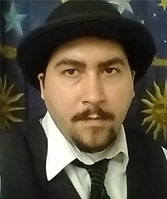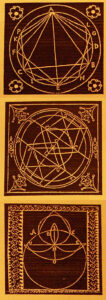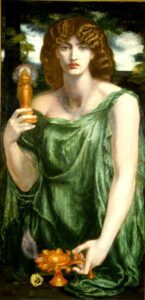The Mystery of Memory
Journeying through Palaces, Mnemonics and Beyond.
By: Benjamin Cote, EA
Sandoval Lodge No. 76

Throughout history, humans have relied on their memory to save and share information and relied on this communication to spread their culture, their knowledge, and their wisdom. A sacred role or office arose for the communication and preservation of their traditions, a member of the community dedicated to preserving through living memory their way of life and communicating that to the proceeding generations which generated archetypes such as The Storyteller, The Bard or Minstrel and The Village Elder. This trickles down even today into the family with the parents & grandparents being the sacred keepers of their family history or the family memory.

Since primordial times, memory has played a role in our lives and the lives of the community. There exists an individual as well as a collective memory of the people of a community which in ancient times was expressed through Myth, Poetry, Music, and Ritual. The Greeks, for instance, gave this a name and place in their divine hierarchy, calling her Mnemosyne, Titan Goddess of Memory, Mother of the 9 Muses who represented the arts of poetry, history, comedy, tragedy, sacred hymn, and dance and astronomy. The Egyptians expressed this through their scribal priesthood, temple science, and festivals. This art was also practiced by the Christian Mystics of the Medieval and Renaissance periods and embedded in their architecture with prominent figures being Giordano Bruno who wrote several treatises on the art of memory and Teresa of Avila’s work on the Interior Castle and traveled through the songs of the troubadours and the architecture of the chapels and cathedrals.
We can see an example of this relationship very clearly in music and poetry with people expressing their feelings and ideas about life and events often in a structured rhyming verse which itself is an aid to memory by associating certain words and giving them a certain mathematical harmony through language. We can see this on a grander scale through epic poetry and mythology where certain truths about life are expressed poetically through the journeys of great characters representing the greatest concepts, archetypes, and greatest feelings known to man such as Time, Nature, Eternity, Love, War, Strife, Elation, The Hero’s Journey, The Harvest Cycle of the Year, Family Life, the rich and the downtrodden, etc. Cosmic Dramas about life and the human condition re-enacted in great plays and rituals, told and retold by great poets and embedded into local customs and festivals, hidden in great works of art like those of the Renaissance masters and written into our very architecture and political systems.
This also happens to be part of how we structure our psyche and worldview. The unconscious part of our mind houses a tapestry of all the things we learn and experience, all the things we receive from the external world through our senses as well as all the things we’ve contemplated and felt internally and accepted as knowledge. The results of all this we call our lives and our truth. A lot of memory is automatic for us, we regularly experience memory in a passive way when things are “happening to us”. Certain moments like traumatic experiences can even get written automatically to long-term memory bypassing short-term memory because of its seriousness and emotional content. The rest of the time we have to actively seek to get information into our heads and hope that it sticks in there somehow. Well, I hope to shed some light on a few ways to go about that.
In certain models of Esoteric Psychology, it is said that the mediator and harmonizing place between the conscious and unconscious mind resides in the imagination. The conscious mind is likened to a little scientist who actively observes the world and makes decisions about what to do in life, while the unconscious mind passively records all the information that is received and stores it in a great library of data. In this model, for us to visualize and imagine things both the conscious and the unconscious mind need to meet in the middle. When we actively seek recollection, the unconscious mind goes and looks up the records and hands us a series of images and information related to what it is we were trying to recollect for our careful consideration until we feel we are satisfied. That information retrieval is what is visualized in the landscape of the imagination and new images can also be formed there.

Using our imagination, we can visualize and create our own new records, bridge connections between thoughts, feelings, and concepts, write our own stories, and generate our works of art. It is a whole internal landscape where we play the role of creator, preserver, and destroyer if we so choose to. It is a great power and it is well known if not very well understood. The police know this very well, witness testimonies at the same event can be different, people remember different things about it and sometimes try to fill in the rest when nothing comes to mind immediately; they can actively change their story over time just by trying to piece everything together, even the most honest of people can do this. We can and do alter our memories to serve certain purposes, be it to preserve the dignity of a loved one who’s done a perceived wrong or to satirize and slander them for it, and it all happens in that magical place called the imagination.
This is where our big technique comes in. It’s a technique called The Mind Palace or Mind Journeys and it uses something called Spatial Memory. You build up a scene in the imagination for something you wish to remember and populate it with events and senses that have corresponding meanings. Spatial memory also has a time dimension to it that works hierarchically, kind of like walking up a flight of steps. “This happened and then this happened”, walking up the staircase. Then you can say “This is why that happened and this is what I think it meant.” You begin with a certain populated landscape and then time starts and events start happening. This is another way of associating certain images or symbols with concepts or specific words you need to be able to recall at a later time. They say ancient Man required a clear memory of where to go to find water sources, plants, hunting grounds, or places of danger like natural hazards or hostile territories, so we developed a greater capacity that makes it quicker and easier to memorize certain details of events and traversal through spaces rather than specific information like words from a book or math formulas. The secret is that they are images in the mind that recall more details.
The fun part about this is that it doesn’t even have to be a real place or event. It can be entirely symbolic and mnemonic. You can build King Solomon’s Temple in your mind and populate it with all sorts of figures and events that have entirely symbolic meanings and associations. Each symbol and symbolic act is a prompt for another set of ideas meant to house certain profound life lessons or philosophical concepts. This is, in fact, a great key to mystery plays, myths, fairy tales, and allegories. If you can get the story and props down right and understand its esoteric or philosophical elements, it will keep bearing fruit through one’s relationship to it and meditation or contemplation upon its mysteries. This is also to say that we learn through association, so understanding what a text means will allow you to remember it more clearly and fully than if you had tried to memorize something that doesn’t mean anything to you, that you don’t understand and thus can’t associate with anything. Think, “spirit of the law vs. the word of the law”.

In Freemasonry, we have the Trestle boards which in operative masonry were the building plans on the drawing board that the master craftsman would draw up which would act as the labor plans for that day. In our degree work, we have just such a trestle board or roadmap that explains the tools and symbols of the work for each degree but it is up to the Mason to investigate those symbols and tools and learn to apply them to their personal lives. The old Alchemists also practiced this, devising emblematic maps for the great work of the transformation of matter, often understood esoterically to be the steps and processes involved in the transformation of the soul. The bulk of alchemical symbols are derived from nature itself in the form of classical elements, various animals, and things taken from astronomy like the planets and zodiac. A microcosmic mind palace filled with the entirety of the macrocosm so that one might more readily perceive the occult or hidden relationships between their inner nature and that of the outer nature which afforded them a mystical relationship with both realms and with that of the eternal realm of ideal forms. Pursuing these ideal forms allows us to strive for greater and greater being and self-mastery and generate that into the world. The way of perfection that countless mystics have talked about.
In our moral lives, we recall these ideal symbols and associated feelings to make moral decisions about what to do in life which equally rests upon our philosophies to inform us about what our ideals and values mean to us personally and what results we think they will have on the world. Through studying philosophy we can answer the great question, “What should I do and why?”. Memory plays a large role in this naturally, we work through our existing knowledge and experience to sort out what we ought to do based on reason and rationale. Giordano Bruno wrote about this by giving certain memory mandalas that allow us to have better working relationships with people through better decision-making. I would highly recommend anyone interested in the art of memory to look him up. The Stoics, have great symbols and sayings that show them how they ought to live and what’s important when deciding on how to react and interact with the world through their stoic virtues also known as the cardinal virtues which are often represented by certain symbols or images that recall those virtues such as a Lion for Courage, an Owl for Wisdom, Scales for Justice and a goblet for Temperance. We find this with the stoic mottos such as Amor Fati, “The love of fate”, often found with the symbol of a rose, or Memento Mori, “Remember that you, too, shall perish.” often found with the image of a skull.
These are memory devices that remind a person of the philosophies they’ve adopted and strive to follow often because this is what they believe to be right and just or at least useful to their lives. In that, I hope that this paper has also been useful to you. While conducting additional research for this paper, I was opened to quite a larger world than I initially anticipated. I knew about the memory palace and the use of mnemonics and stories to improve memory retention but what I found was more profound and meaningful than that. I didn’t even get into a lot of what I found and I would encourage anyone to conduct their research into the world and mystery of memory, you may be surprised at how relevant it is to our everyday lives /G\
